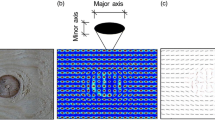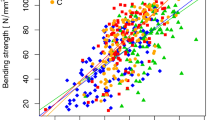Abstract
Strength grading of timber boards is an important step before boards can be used as lamellas in glued laminated timber. Grading is generally done visually or by machine, whereby machine grading is the faster and more accurate process. Machine grading gives the best strength prediction when dynamic modulus of elasticity (MoEdyn) is measured and some kind of knot assessment algorithm is included as well. As access to the actual density for the measurement of MoEdyn may be impossible in some conditions, this grading method may face some problems in strength prediction. As the strength of a board is related to its natural defects and the ability of the stress waves to propagate around these defects, a virtual method for more accurate strength predictions is developed based on the knot information on the surface. Full 3D reconstruction of the boards, based on knot information on the surfaces of these boards, is an important step in this study. Simulations were run for 450 boards of spruce, Douglas fir, beech, ash and maple, covering a large quality range. Abaqus and Python were used for the numerical simulations. From the numerical simulations, three different stress concentration factors were calculated in the vicinity of the defects. Additionally, a virtual longitudinal stress wave propagation was modeled for the determination of the dynamic modulus of elasticity. The FEM results were used to predict the tensile strength. By means of a regression analysis, the correlation with actual visual and machine readings was validated. An improvement in the strength prediction was observed based on the virtual method, when compared to currently available grading machines. It shows the potential of numerical methods for strength prediction of wood based on visual knot information.










Similar content being viewed by others
References
Baño V, Arriaga F, Soilán A, Guaita M (2010) F.E.M. analysis of the strength loss in timber due to the presence of knots. In: World conference on timber engineering, Riva del Garda, pp 3–7. ISBN: 978-88-901660
Baudoin A, Skalli W, de Guise J, Mitton D (2008) Parametric subject-specific model for in vivo 3D reconstruction using bi-planar X-rays: application to the upper femoral extremity. Med Biol Eng Comput 46(8):799–805
Bodig J, Jayne BA (1993) Mechanics of wood and wood composites, 2nd edn. Krieger Publishing Company, New York. ISBN 13: 9780894647772
Bulleit WM, Falk RH (1985) Modeling stress wave passage times in wood utility. Wood Sci Technol 19:183–191
Cramer SM, Goodman JR (1982) Model for stress analysis and strength prediction of lumber. Wood Fiber Sci 15(4):338–349
Cramer SM, Goodman JR (1986) Failure modeling: a basis for strength prediction of lumber. Wood Fiber Sci 18:446–459
DIN 4074-1 (2012) Strength grading of wood—part 1: coniferous sawn timber. German Institute for Standardization, Berlin
Durelli AJ, Lake RL, Phillips E (1952) Stress distribution in plates under a uniaxial state of stress with multiple semi-circular and flat-bottom notches. In: Proceedings of the first national congress on applied mechanics. American Society of Mechanical Engineers, pp 309–315
EN 408 (2010) Timber structures—structural timber and glued laminated timber—determination of some physical and mechanical properties. CEN, Brussels
Foley C (2001) A three-dimensional paradigm of fibre orientation in timber. Wood Sci Technol 35:453–465
Giudeiceandrea F, Ursella E, Vicario E, Rais A (2018) Increasing the value of strength graded timber by industrial computer tomography. In: Wood conference in timber engineering, Vienna
Goodman JR, Bodig J (1978) Mathematical model of the tension behavior of wood with knots and cross grain. In: Proceedings from the first international conference on wood fracture, Banff
Goodman JR, Bodig J (1980) Tension behavior of wood—an anisotropic, inhomogeneous material. Structural research report No. 32. Colorado State University, Fort Collins
Graham RH, Raines M, Swift KG, Gill L (2005) Prediction of stress concentrations associated with interacting stress-raisers within aircraft design: methodology development and application. Proc Inst Mech Eng Part G J Aerosp Eng 219(3):193–203
Guindos P, Guaita M (2013) A three-dimensional wood material model to simulate the behavior of wood with any type of knot at the macro-scale. Wood Sci Technol 47:585–599
Hackspiel C, de Borst K, Lukacevic M (2014) A numerical simulation tool for wood grading model development. Wood Sci Technol 48(3):633–649. https://doi.org/10.1007/s00226-014-0629-0
Haddon RAW (1967) Stresses in an infinite plate with two unequal circular holes. Q J Mech Appl Math 20:277–291
Hazrati Marangalou J, Ito K, Cataldi M, Taddei F, van Rietbergen B (2013) A novel approach to estimate trabecular bone anisotropy using a database approach. J Biomech 46:2356–2362
Hu M, Briggert A, Olsson A, Johansson M, Oscarsson J, Säll J (2018) Growth layer and fiber orientation arount knots in Norway spruce: a laboratory investigation. Wood Sci Technol 52(1):7–27. https://doi.org/10.1007/s00226-017-0952-3
Jenkel C (2016) Structural and material inhomogeneities in timber, modelling by means of the finite element method. Dissertation, Technische Universität Dresden
Jenkel C, Kaliske M (2013) Analyse von Holzbauteilen unter Berücksichtigung struktureller Inhomogenitäten (Analysis of timber components taking into account structural inhomogeneities). Bauingenieur 88:494–507 (in German)
Kandler G, Lukacevic M, Füssl J (2016) An algorithm for the geometric reconstruction of knots within timber boards based on fibre angle measurements. Constr Build Mater 124:945–960
Khaloian A, Gard WF, van de Kuilen JW (2017) 3D FE-numerical modelling of growth defects in medium dense European hardwoods. In: Proceedings of the sixth international scientific conference on hardwood processing, Lahti, pp 60–67
Kim JH, Anandakumar G (2010) Stress wave propagation in functionally graded solids under impact loading. In: Proceedings of the IMPLAST 2010 conference. Rhode Island
Kowalczyk P (2010) Simulation of orthotropic microstructure remodelling of cancellous bone. J Biomech 43:563–569. https://doi.org/10.1016/j.jbiomech.2009.09.045
Lang R, Kaliske M (2013) Description of inhomogeneities in wooden structures: modelling of branches. Wood Sci Technol 47:1051–1070
Ling CB (1948) On the stresses in a plate containing two circular holes. J Appl Phys 19:77–82
Lukacevic M, Füssl J (2014) Numerical simulation tool for wooden boards with a physically based approach to identify structural failure. Eur J Wood Prod 72:497–508
Lukacevic M, Füssl J, Eberhardsteiner J (2015) Discussion of common and new indicating properties for the strength grading of wooden boards. Wood Sci Technol 49:551–576
NASA (1975) Astronautic structures manual, vol 1. George C. Marshall Space Flight Center, Marshall Space Flight Center, Huntsville
Nath S (2013) Stress wave propagation in split Hopkinson pressure bar. Master’s thesis, National Institute of Technology Rourkela
Nilsson C (2009) Modelling of dynamically loaded shotcrete. Master’s thesis, Royal Institute of Technology, Stockholm. ISSN: 1103-4297
Olsson A, Oscarsson J, Johansson M, Källsner B (2012) Prediction of timber bending strength on basis of bending stiffness and material homogeneity assessed from dynamic excitation. Wood Sci Technol 46(4):667–683
Olsson A, Oscarsson J, Serrano E, Källsner B, Johansson M, Enquist B (2013) Prediction of timber bending strength and in-member cross-sectional stiffness variation on the basis of local wood fibre orientation. Eur J Wood Prod 71(3):319–333
Oscarsson J (2014) Strength grading of structural timber and EWP laminations of Norway spruce-development potentials and industrial applications. Doctoral thesis, Linnaeus University
Phillips GE, Bodig J, Goodman JR (1981) Flow-grain analogy. Wood Sci 14:55–65
Pilkey WD (1997) Peterson’s stress concentration factors, 2nd edn. Wiley, New York
Pilkey WD, Pilkey DF (2008) Peterson’s stress concentration factors, 3rd edn. Wiley, New York
Rais A, Poschenrieder W, Pretzsch H, van de Kuilen JWG (2014a) Influence of initial plant density on sawn timber properties for Douglas-fir (Pseudotsuga menziesii (Mirb.) Franco). Ann For Sci 71:617–626
Rais A, van de Kuilen JWG, Pretzsch H (2014b) Growth reaction patterns of tree height, diameter, and volume of Douglas-fir (Pseudotsuga menziesii [Mirb.] Franco) under acute drought stress in Southern Germany. Eur J For Res 133(6):1043–1056. https://doi.org/10.1007/s10342-014-0821-7
Shantharaja M, Sandeep GM (2014) Experimental and numerical analysis of propagation of stress wave in sheet metal. Int J Sci Technol Res 3(10):40–42. ISSN: 2277-8616
Stapel P, van de Kuilen JWG (2013) Effects of grading procedures on the scatter of characteristic values of European grown sawn timber. Mater Struct 46:1587–1598. https://doi.org/10.1617/s11527-012-9999-7
Stapel P, van de Kuilen JWG (2014a) Influence of cross-section and knot assessment on the strength of visually graded Norway spruce. Eur J Wood Prod 72(2):213–227. https://doi.org/10.1007/s00107-013-0771-7
Stapel P, van de Kuilen JWG (2014b) Efficiency of visual strength grading of timber with respect to origin, species, cross section, and grading rules: a critical evaluation of the common standards. Holzforschung 68(2):203–216. https://doi.org/10.1515/hf-2013-0042
Suiker ASJ, Metrikine AV, de Borst R (2001) Comparison of wave propagation characteristics of the Cosserat continuum model and corresponding discrete lattice models. Int J Solids Struct 38:1563–1583
Tabor Z, Rokita E (2007) Quantifying anisotropy of trabecular bone from gray-level images. Bone 40(4):966–972
Verner EA, Becket EB (1973) Finite element stress formulation for wave propagation. Int J Numer Methods Eng 7:441–459
Whitley DW (2013) Interacting stress concentration factors and their effect on fatigue of metallic aerostructures. Doctoral thesis, Missouri University of Science and Technology
Zandbergs JG, Smith FW (1987) Finite elements fracture prediction for wood with knots and cross grain. Wood Fiber Sci 20:97–106
Acknowledgements
The authors gratefully acknowledge the support of the Bayerische Landesanstalt für Wald und Forstwirtschaft for funding the Project X042 “Beechconnect” which allowed for the work presented in this paper.
Author information
Authors and Affiliations
Corresponding author
Ethics declarations
Conflict of interest
On behalf of all authors, the corresponding author states that there is no conflict of interest.
Additional information
Publisher's Note
Springer Nature remains neutral with regard to jurisdictional claims in published maps and institutional affiliations.
Electronic supplementary material
Below is the link to the electronic supplementary material.
Rights and permissions
About this article
Cite this article
Khaloian Sarnaghi, A., van de Kuilen, J.W.G. An advanced virtual grading method for wood based on surface information of knots. Wood Sci Technol 53, 535–557 (2019). https://doi.org/10.1007/s00226-019-01089-w
Received:
Published:
Issue Date:
DOI: https://doi.org/10.1007/s00226-019-01089-w




